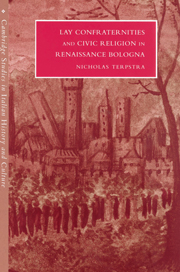Book contents
- Frontmatter
- Contents
- List of figures
- List of tables
- Acknowledgments
- Preface
- Prologue
- 1 The early quattrocento: confraternities, observance movements, and the civic cult
- 2 Lay spirituality and confraternal worship
- 3 The mechanics of membership
- 4 Communal identity, administration, and finances
- 5 Confraternal charity and the civic cult in the late fifteenth and early sixteenth centuries
- Epilogue
- Bibliography
- Index
1 - The early quattrocento: confraternities, observance movements, and the civic cult
Published online by Cambridge University Press: 24 September 2009
- Frontmatter
- Contents
- List of figures
- List of tables
- Acknowledgments
- Preface
- Prologue
- 1 The early quattrocento: confraternities, observance movements, and the civic cult
- 2 Lay spirituality and confraternal worship
- 3 The mechanics of membership
- 4 Communal identity, administration, and finances
- 5 Confraternal charity and the civic cult in the late fifteenth and early sixteenth centuries
- Epilogue
- Bibliography
- Index
Summary
From 1385 northern Italy witnessed the relentless advance of Giangaleazzo Visconti. Having secured the territories of Milan by overturning his uncle and father-in-law Bernabò, he proceeded through arms and diplomacy to dominate and in places subject the communes of Romagna, Tuscany, and Umbria. The hastily knit alliances of these communes unravelled before him, and he in turn used their forces to string a tighter noose around the prizes which eluded him. In July 1402, Bologna was the last major city to fall to Visconti. From there he marched to what was to be the final triumph in the siege of Florence. Plague claimed Giangaleazzo and Florence claimed the triumph; the empire which Visconti had shaped over seventeen years quickly disintegrated. Hans Baron noted the effect of Visconti's empire in shaping Florentine republicanism, but there has been less attention paid to those communes whose resistance failed. In the case of Bologna, the Visconti threat was a catalyst which brought together religious and political movements and which turned confraternities more decidedly towards the shaping of the civic cult that had begun with construction of San Petronio.
Bologna's religious response to the Visconti threat focused around a procession and a shrine: the 1399 processions of the Bianchi movement, and the 1401 creation of the shrine of S. Maria del Baraccano.
- Type
- Chapter
- Information
- Publisher: Cambridge University PressPrint publication year: 1995



